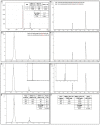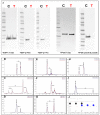Affinity-Bead Assisted Mass Spectrometry (Affi-BAMS): A Multiplexed Microarray Platform for Targeted Proteomics
- PMID: 32188029
- PMCID: PMC7139916
- DOI: 10.3390/ijms21062016
Affinity-Bead Assisted Mass Spectrometry (Affi-BAMS): A Multiplexed Microarray Platform for Targeted Proteomics
Abstract
The ability to quantitatively probe diverse panels of proteins and their post-translational modifications (PTMs) across multiple samples would aid a broad spectrum of biological, biochemical and pharmacological studies. We report a novel, microarray analytical technology that combines immuno-affinity capture with Matrix Assisted Laser Desorption Ionization Mass Spectrometry (MALDI MS), which is capable of supporting highly multiplexed, targeted proteomic assays. Termed "Affinity-Bead Assisted Mass Spectrometry" (Affi-BAMS), this LC-free technology enables development of highly specific and customizable assay panels for simultaneous profiling of multiple proteins and PTMs. While affinity beads have been used previously in combination with MS, the Affi-BAMS workflow uses enrichment on a single bead that contains one type of antibody, generally capturing a single analyte (protein or PTM) while having enough binding capacity to enable quantification within approximately 3 orders of magnitude. The multiplexing capability is achieved by combining Affi-BAMS beads with different protein specificities. To enable screening of bead-captured analytes by MS, we further developed a novel method of performing spatially localized elution of targets from individual beads arrayed on a microscope slide. The resulting arrays of micro spots contain highly concentrated analytes localized within 0.5 mm diameter spots that can be directly measured using MALDI MS. While both intact proteins and protein fragments can be monitored by Affi-BAMS, we initially focused on applying this technology for bottom-up proteomics to enable screening of hundreds of samples per day by combining the robust magnetic bead-based workflow with the high throughput nature of MALDI MS acquisition. To demonstrate the variety of applications and robustness of Affi-BAMS, several studies are presented that focus on the response of 4EBP1, RPS6, ERK1/ERK2, mTOR, Histone H3 and C-MET to stimuli including rapamycin, H2O2, EPO, SU11274, Staurosporine and Vorinostat.
Keywords: BAMS; MALDI MS; PTMs; bead assisted mass spectrometry; multiplex assays; targeted proteomics.
Conflict of interest statement
The authors declare no conflict of interest. The funders had no role in the design of the study; in the collection, analyses, or interpretation of data; in the writing of the manuscript, or in the decision to publish the results.
Figures











Similar articles
-
Affi-BAMS™: A Robust Targeted Proteomics Microarray Platform to Measure Histone Post-Translational Modifications.Int J Mol Sci. 2023 Jun 13;24(12):10060. doi: 10.3390/ijms241210060. Int J Mol Sci. 2023. PMID: 37373206 Free PMC article.
-
Correlated matrix-assisted laser desorption/ionization mass spectrometry and fluorescent imaging of photocleavable peptide-coded random bead-arrays.Rapid Commun Mass Spectrom. 2014 Jan 15;28(1):49-62. doi: 10.1002/rcm.6754. Rapid Commun Mass Spectrom. 2014. PMID: 24285390 Free PMC article.
-
Peptide and Protein Quantification Using Automated Immuno-MALDI (iMALDI).J Vis Exp. 2017 Aug 18;(126):55933. doi: 10.3791/55933. J Vis Exp. 2017. PMID: 28872133 Free PMC article.
-
Food allergen analysis: A review of current gaps and the potential to fill them by matrix-assisted laser desorption/ionization.Compr Rev Food Sci Food Saf. 2023 Sep;22(5):3984-4003. doi: 10.1111/1541-4337.13216. Epub 2023 Aug 2. Compr Rev Food Sci Food Saf. 2023. PMID: 37530543 Review.
-
Applications of MALDI-MS/MS-Based Proteomics in Biomedical Research.Molecules. 2022 Sep 21;27(19):6196. doi: 10.3390/molecules27196196. Molecules. 2022. PMID: 36234736 Free PMC article. Review.
Cited by
-
Targeting protein modifications in metabolic diseases: molecular mechanisms and targeted therapies.Signal Transduct Target Ther. 2023 May 27;8(1):220. doi: 10.1038/s41392-023-01439-y. Signal Transduct Target Ther. 2023. PMID: 37244925 Free PMC article. Review.
-
Affi-BAMS™: A Robust Targeted Proteomics Microarray Platform to Measure Histone Post-Translational Modifications.Int J Mol Sci. 2023 Jun 13;24(12):10060. doi: 10.3390/ijms241210060. Int J Mol Sci. 2023. PMID: 37373206 Free PMC article.
-
Chemical biology approaches to study histone interactors.Biochem Soc Trans. 2021 Nov 1;49(5):2431-2441. doi: 10.1042/BST20210772. Biochem Soc Trans. 2021. PMID: 34709376 Free PMC article. Review.
-
Integrated -omics approach reveals persistent DNA damage rewires lipid metabolism and histone hyperacetylation via MYS-1/Tip60.Sci Adv. 2022 Feb 18;8(7):eabl6083. doi: 10.1126/sciadv.abl6083. Epub 2022 Feb 16. Sci Adv. 2022. PMID: 35171671 Free PMC article.
-
Runx1-R188Q germ line mutation induces inflammation and predisposition to hematologic malignancies in mice.Blood Adv. 2023 Dec 12;7(23):7304-7318. doi: 10.1182/bloodadvances.2023010398. Blood Adv. 2023. PMID: 37756546 Free PMC article.
References
-
- Meier F., Brunner A.-D., Koch S., Koch H., Lubeck M., Krause M., Goedecke N., Decker J., Kosinski T., Park M.A., et al. Online Parallel Accumulation–Serial Fragmentation (PASEF) with a Novel Trapped Ion Mobility Mass Spectrometer. Mol. Cell. Proteom. 2018;17:2534–2545. doi: 10.1074/mcp.TIR118.000900. - DOI - PMC - PubMed
MeSH terms
Substances
Grants and funding
LinkOut - more resources
Full Text Sources
Other Literature Sources
Molecular Biology Databases
Research Materials
Miscellaneous

